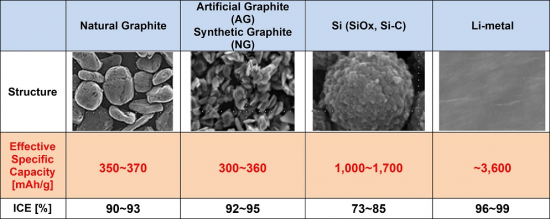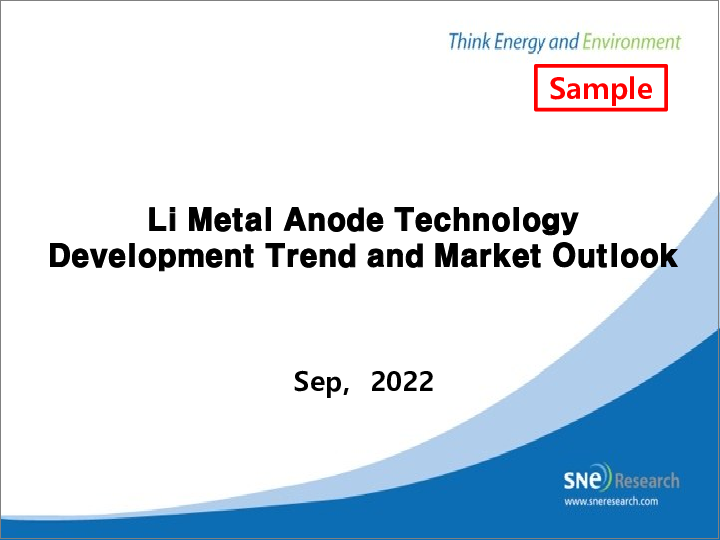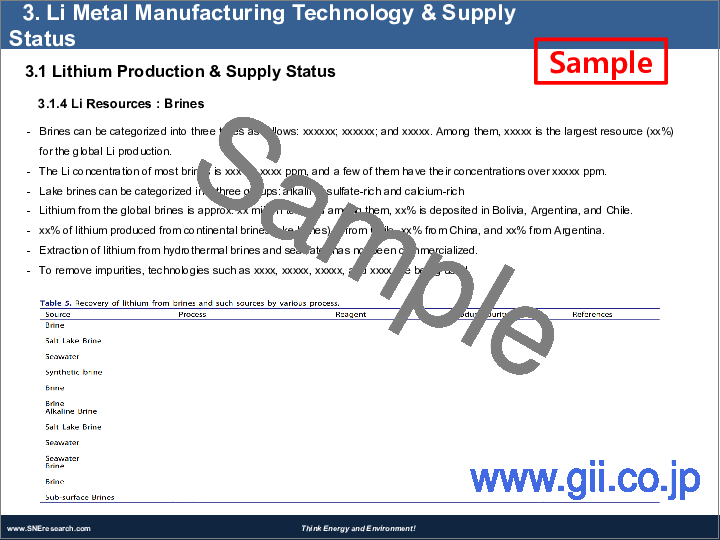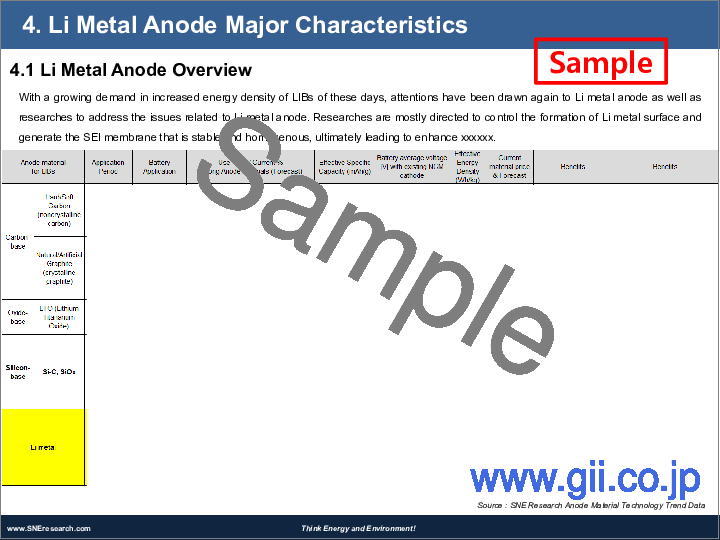|
|
市場調査レポート
商品コード
1132150
リチウム金属アノード技術の開発動向と市場の見通し:2022年<2022> Li Metal Anode Technology Development Trends and Market Outlook |
||||||
| リチウム金属アノード技術の開発動向と市場の見通し:2022年 |
|
出版日: 2022年09月19日
発行: SNE Research
ページ情報: 英文 210 Pages
納期: お問合せ
|
- 全表示
- 概要
- 目次
21世紀に入り、地球環境保全や持続可能な社会構築に向けたさまざまな活動が行われ、深刻化する気候変動問題に対応するため、環境規制が強化される中、再生可能エネルギーやクリーンエネルギー技術の開発の必要性が高まってきています。二次電池産業は、環境に優しいエネルギーの代表的な産業の1つです。内燃機関による車両から電気自動車へと移動手段が変化していく中で、各種リチウムイオン電池の研究が以前にも増して盛んに行われています。
当レポートでは、将来的に最も有望なアノード材料の1つと見なされているリチウム金属に焦点を当てて、最近の技術動向のほか、韓国、中国、日本、その他の国におけるリチウム金属技術の研究開発状況について詳しく取り上げています。サプライヤーと消費者の両方の観点から市場動向を分析し、ICE・xEV市場に基づき、2030年までのリチウム金属アノード市場における需要と市場規模に関する予測も提供しています。
レポートの強み:
- 1. リチウム金属の生産技術の概要と問題
- 2. リチウム金属アノードの全体的な研究開発動向の理解
- 3. リチウム金属アノードの主要企業とその技術動向や戦略

目次
第1章 イントロダクション
- LIBの要件
- LIBの開発動向
第2章 アノード材料の技術と開発動向
- LIBアノードの概要
- LIBアノード材料の開発動向
第3章 リチウム金属の製造技術と供給状況
- リチウムの生産と供給状況
- リチウム金属の製造技術
- リチウム金属の生産問題
第4章 リチウム金属アノード技術と主な特徴
- リチウム金属アノードの概要
- リチウム金属アノードの開発の歴史
- リチウム金属アノードの研究開発動向
- リチウム金属アノードの問題
第5章 リチウム金属の開発状況:企業別
- 概要
- アジアの企業
- Samsung SDI
- LGES
- SK on
- CATL
- Prologium
- Hyundai Motor
- POSCO Chem.
- Neba Corp
- Ulvac Inc
- Santoku
- Honjo metal
- Wuxi Sunenergy Lithium Industrial Co
- China Energy Lithium Co
- Ganfeng Lithium
- Tianqi Lithium
- Softbank Next-generation Lab
- AIST
- NIMS - ALCA SPRING
- 欧州の企業
- Blue Solutions
- Volkswagen
- DAIMLER
- SIDRABE
- IMEC
- 北米の企業
- SES
- QuantumScape
- Solid Power
- SOELECT
- TeraWatt
- Hydro Quebec
- Brightvolt
- Sion Power
- SEEO
- Cuberg
- Enpower Greentech
- PolyPlus
- Sepion Technologies Inc
- Ion Storage Systems
- GM
- Li Metal Corp
- Ionic Materials
- Albemarle
- SQM
- Livent Corp
- Pure Lithium Corp
- 主要企業の概要
第6章 リチウム金属アノード市場の見通し(2030年まで)
- 概要
- リチウム金属アノード電池の種類とリチウム金属のコスト構成
- リチウム金属アノードの用途のロードマップ
- リチウム金属アノードの商業化シナリオ
- リチウム金属アノード市場の見通し
- リチウム金属アノードの需要の見通し
- リチウム金属アノードの価格の見通し(保守的シナリオ)
- リチウム金属アノードの価格の見通し(楽観的シナリオ)
- リチウム金属アノードの価格の見通しベース
- リチウム金属アノードの市場規模の見通し(保守的シナリオ)
- リチウム金属アノードの市場規模の見通し(楽観的シナリオ)
- 全固体LMBの価格の見通し(保守的シナリオ)
- 全固体LMBの価格の見通し(楽観的シナリオ)
- 全固体LMBの価格の見通し(保守的シナリオ)
- 全固体LMBの価格の見通し(楽観的シナリオ)
- 全固体LMBの使用率
- リチウム金属アノードの見通し:用途別
Amidst various activities to conserve the environment and establish a sustainable society carried out across the board and stricter environment regulations in place to address ever-worsening climate change issues in the 21st century, there has been a growing significance on the necessity of developing renewable energy and clean energy technologies. The secondary battery industry is one of the representative industries for eco-friendly energy. As our means of transportation has been transformed from vehicles with internal combustion engine to electric vehicles, research on various types of lithium-ion battery has become more active than ever before.
Since the commercialization of lithium-ion battery in the 1990s, lithium-ion battery has been successfully utilized as a power source for commercial electronic products and electric vehicles for the past several decades. However, the existing lithium-ion battery using a graphite anode has low theoretical capacity (~372 mAh/g) and volumetric capacity (~735 mAh/cm3) of anode, which imposes a limit on the upward adjustment of energy density achieved by lithium-ion battery. To meet a growing demand of lithium secondary battery, a new battery technology transcending the existing lithium-ion battery should be inevitably pursued.
Lithium metal has significantly high, theoretical capacity (~3860 mAh/g), very low electrochemical potential (-3.04 V, compared to hydrogen electrode), and very low density (0.53g/cm3). Thanks to these characteristics, lithium metal anode is evaluated as the most potential material that can achieve high capacity and power output per unit weight and unit volume.
This report covers the recent technology trend with a focus on lithium metal that is regarded as one of the most promising materials for anode in future. In addition, the report also takes a close look at the status of research and development of lithium metal technology in Korea, China, Japan, and other countries. In the final part, the report analyzes the market trend both from the perspectives of suppliers and consumers. In addition, the report offers a forecast on the lithium metal anode market demand and market scale till 2030 based on the ICE and xEV markets.
This report has the following strong points:
- 1. Overview of Li Metal Production Technology and Issues
- 2. Understanding of Overall Research and Development Trend for Li Metal Anode
- 3. Major Players for Li Metal Anode and Their Technology Trend and Strategy

Table of Contents
1. Introduction
- 1.1 LIB Requirements
- 1.2 LIB Development Trend
2. Anode Material Technology and Development Trend
- 2.1 LIB Anode Overview
- 2.2 LIB Anode Material Development Trend
3. Li Metal Manufacturing Technology and Supply Status
- 3.1 Lithium Production and Supply Status
- 3.1.1 Lithium world reserves - consumption
- 3.1.2 World Li Volumes - Current Production
- 3.1.3 World Li mine Production - Demand
- 3.1.4 Li resources : Mineral
- 3.1.5 Li resources : Ores
- 3.1.6 Li resources : Brines
- 3.1.7 Li Materials Supply Structure
- 3.2 Li Metal Manufacturing Technology
- 3.2.1 Li material technology
- 3.2.2 Li thin film technology
- 3.3 Li Metal Production Issues
- 3.3.1 Li thin film technology limitations
- 3.3.2 Cost Structure
4. Li Metal Anode Technology and Major Characteristics
- 4.1 Li Metal Anode Overview
- 4.2 Li Metal Anode Development History
- 4.2.1 History Overview
- 4.2.2 Li metal battery(LMB) History
- 4.2.3 Li metal battery(LMB) Initial Development
- 4.2.4 LIB Development & Market Domination
- 4.2.5 Emergence of Necessity for LMB
- 4.3 Li metal anode R&D Trend
- 4.3.1 Artificial surface protective film (ASEI formation)
- 4.3.2 New Structure
- 4.3.3 Electrolyte modification
- 4.4 Li metal anode issue
- 4.4.1 Li dendritic growth
- 4.4.2 SEI Layer issue
5. Li Metal Development Status by Company
- 5.1 Overview
- 5.2 Companies in Asia
- 5.2.1 Samsung SDI
- 5.2.2 LGES
- 5.2.3 SK on
- 5.2.4 CATL
- 5.2.5 Prologium
- 5.2.6 Hyundai Motor
- 5.2.7 POSCO Chem.
- 5.2.8 Neba Corp
- 5.2.9 Ulvac Inc
- 5.2.10 Santoku
- 5.2.11 Honjo metal
- 5.2.12 Wuxi Sunenergy Lithium Industrial Co
- 5.2.13 China Energy Lithium Co
- 5.2.14 Ganfeng Lithium
- 5.2.15 Tianqi Lithium
- 5.2.16 Softbank Next-generation Lab
- 5.2.17 AIST
- 5.2.18 NIMS - ALCA SPRING
- 5.3 Companies in Europe
- 5.3.1 Blue Solutions
- 5.3.2 Volkswagen
- 5.3.3 DAIMLER
- 5.3.4 SIDRABE
- 5.3.5 IMEC
- 5.4 Companies in North America
- 5.4.1 SES
- 5.4.2 QuantumScape
- 5.4.3 Solid Power
- 5.4.4 SOELECT
- 5.4.5 TeraWatt
- 5.4.6 Hydro Quebec
- 5.4.7 Brightvolt
- 5.4.8 Sion Power
- 5.4.9 SEEO
- 5.4.10 Cuberg
- 5.4.11 Enpower Greentech
- 5.4.12 PolyPlus
- 5.4.13 Sepion Technologies Inc
- 5.4.14 Ion Storage Systems
- 5.4.15 GM
- 5.4.16 Li Metal Corp
- 5.4.17 Ionic Materials
- 5.4.18 Albemarle
- 5.4.19 SQM
- 5.4.20 Livent Corp
- 5.4.21 Pure Lithium Corp
- 5.5 Summary of Major Companies
6. Outlook for Li Metal Anode Market (~`30)
- 6.1 Overview
- 6.1.1 Types of Li metal anode batteries & Composition of Li metal costs
- 6.1.2 Roadmap of Li-metal-anode application
- 6.1.3 Commercialization scenario of Li metal anode
- 6.2 Outlook for Li metal anode market
- 6.2.1 Outlook for Li metal anode demand
- 6.2.2 Outlook for Li metal anode price (Conservative Scenario)
- 6.2.3 Outlook for Li metal anode price (Optimistic Scenario)
- 6.2.4 Base for Price Outlook of Li metal anode
- 6.2.5 Outlook for Li metal anode market mize (Conservative Scenario)
- 6.2.6 Outlook for Li metal anode market mize (Optimistic Scenario)
- 6.2.7 Outlook for Price of All-solid-state LMBs (Conservative)
- 6.2.8 Outlook for price of all-solid-state LMBs (Optimistic)
- 6.2.9 Outlook for Price of All-solid-state LMBs (Conservative)
- 6.2.10 Outlook for Price of All-solid-state LMBs (Optimistic)
- 6.2.11 Percentage of usage of all-solid-state LMBs
- 6.2.12 Outlook for Li metal anode by Application




